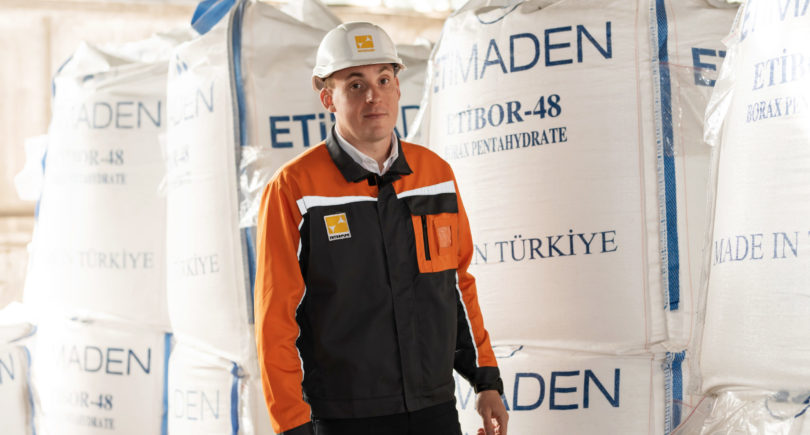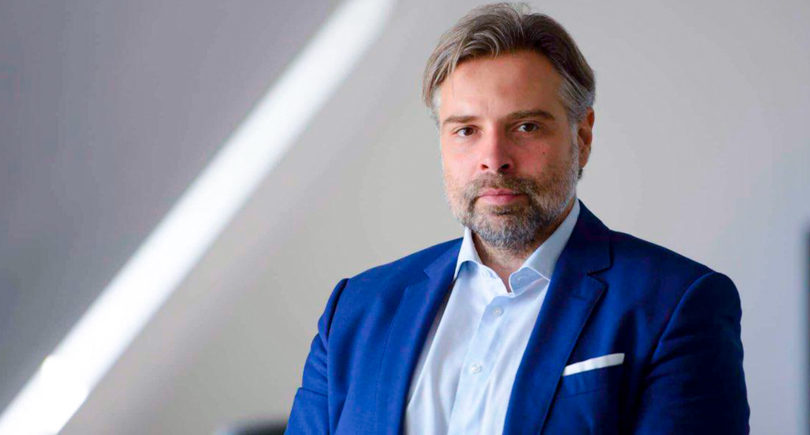
Interviews mining & metals sector of Ukraine 711 18 October 2019
Zaporizhstal CEO tells about how the Company responds to the growing market challenges
The global steel industry is going through difficult times. Over the past year, prices for steel products fell by more than 30%. At the same time, production costs are rising, in particular due to a hike in prices for raw materials. New steel companies emerge in China and India, which adds fuel to the fire.
Zaporizhstal’s margin also decreased amid the unfavorable market situation. However, according to Rostislav Shurma, Zaporizhstal CEO, the Company continues to find optimal ways of maintaining competitiveness. We asked Zaporizhstal CEO about the current expectations for production volumes, low cycle for steelmakers, increasing market competition, projects in progress, and strategic plans for the future.
What are the production targets of Zaporizhstal for 2019? Is the Company able to achieve them?
— The expected performance of Zaporizhstal in 2019 corresponds to that in 2018. 1–2% fluctuations towards an increase or decrease are insignificant. As for pig iron, we expect to produce about 4.3 million tons this year. This is an absolute record for Zaporizhstal.
Amid the growing crisis in the market of steel products, we managed to achieve stable performance. To date, all our production capacities are operating: some of them were upgraded, while others were used to test optimal operating modes and minimize idle hours. Despite the difficult times for steelmakers, Zaporizhstal is still competitive, both in quality and in price.
The steel industry is facing a situation where raw materials are expensive and finished products cheap. Do you have problems in this respect and how do you tackle them?
— All steelmaking companies definitely faced a decrease in the steel price spread: due to a reduction in the difference between steel and raw material prices, our margin decreased. Over the past year, steel prices declined by more than 30%. This puts significant pressure on profit margins in the industry, resulting in a decrease in the margin of companies around the globe. In the recent quarters, almost all steel companies have gone into red.
Zaporizhstal is strongly influenced by these trends: a slightest fluctuation in the exchange rate amid the global market crisis is not in our favor. However, we still manage to maintain balance.
What tools do you use to stay in the market?
— The steel market has to deal with crisis situations all the time. Understanding this, since 2012, we’ve been developing and successfully implementing complex programs to improve efficiency of the Company in all areas. Zaporizhstal streamlined its production facilities. Equipped with four blast furnaces, the Company currently produces 13.5 thousand tons of pig iron per day, exceeding the record of the 1970s, when the same volume was produced in five blast furnaces.
Zaporizhstal is demonstrating a good benchmark in terms of consumption ratios: we reduced coke consumption in pig iron production down to 360 kg (less than 530 kg in terms of total consumption of conventional fuel per ton).
Decreasing the share of energy consumption in steel production is one of the most important areas of our work, because this share ranges from 30% to 40% in the cost structure of steel products. We critically analyzed production and found an opportunity to reduce natural gas consumption. That is to say that earlier, Zaporizhstal burnt out excess volumes of blast furnace gas in waste devices — furnaces. Since 2016, we’ve been implementing a project for exchanging secondary gases between Zaporizhstal and Zaporizhzhia Coke Plant: excess coke oven gas is given to us in exchange for blast furnace gas. In this way, we managed to replace expensive blue fuel with coke and blast furnace as well as natural and blast furnace mixtures in rolling shops, combined heat and power plant, and ignition hoods of sinter machines. We managed to reduce consumption of natural gas in blast-furnace production through the pulverized coal injection technology, and in steelmaking through oxygen blow.
A synthesis of all these solutions allowed Zaporizhstal to reduce consumption of natural gas since 2012 from more than 700 million cubic meters to 160 million cubic meters.
Do you feel increased competition in the market? Who do you consider your main competitor? What are your priority markets?
— We definitely feel a rather strong competition. There are several reasons, but a global economic recession is the key one. Growth is replaced by decline, and the investment market has traditionally responded with a cut in investment due to its reluctance to take risks in these unstable times. As a result, France, Germany and other EU countries are reducing steel consumption. In an effort to protect the interests of its companies, the EU imposes tough safeguard measures on Ukraine. Meanwhile, the supply in the steel market not only remains at the pre-crisis level, but also shows growth due to the commissioning of new capacities, mainly in China and India.
Today, our closest competitors are Chinese companies, some Turkish manufacturers and Russian steelmakers: Magnitka (Magnitogorsk Iron and Steel Works), Novolipetsk Steel and Severstal.
But, as I said earlier, Zaporizhstal maintains its competitive position.
Is the hike in coke prices caused by the suspension of shipments from Russia a problem to your Company?
— Like iron ore, coke is a basic raw material in steelmaking. Minor fluctuations are always noticeable, while drastic changes, say, a lack of high-quality raw material shipments through traditional logistic routes, strongly impact one of the main factors of competitiveness — the primary cost of rolled steel. We started to buy coke from Poland, Kazakhstan and China, but more complex logistic routes produced an immediate impact on the economic component.
What about a project of installing a new galvanizing and polymer coating line? Could you give any details: implementation time limits, projected volumes, amounts of investment?
— This project is being developed by Metinvest Engineering. All questions regarding the project should be addressed to them.

At what stage of implementation is a joint project with the World Bank to develop a system for monitoring greenhouse gas emissions?
— Ukraine has just embarked on the path to creating a system of trading in quotas for greenhouse gas emissions. This market has been successfully operating for many years in Europe, enabling companies to attract green investments to streamline their facilities. In Ukraine, it was necessary to study the specifics of steelmaking plants to implement this initiative. Zaporizhstal and Zaporizhzhia Coke Plant were selected as typical companies.
World Bank’s environmental experts, with the assistance of environmental experts of the companies, have developed an algorithm for the application of the greenhouse gas quotas trading system in Ukraine, based on the EU’s experience.
To date, the plants have developed Greenhouse Gas Emission Monitoring Plans and Emission Monitoring Reports. All inputs have been submitted to the World Bank for review.
At what implementation phase is a project on the reconstruction of a cold rolling mill and the construction of a basic oxygen shop? What, in your opinion, are the chances of getting funding?
— To date, the project is divided into two parallel phases. On the one hand, since 2014, Zaporizhstal has been systematically preparing a site for the construction of a new steelmaking shop. Furthermore, the Company spent more than UAH 200 million for the construction of a four-lane bypass road and transferred it into the ownership of the city.
On the other hand, all design decisions, opening a credit facility, and negotiations with project partners are completely under the control of Metinvest Engineering.
What is your forecast for the steel market for the years to come? What products and markets do you want to focus on?
— The steel market has become cyclical: a rise will be necessarily replaced with a recession and vice versa. The past few years were definitely good for steelmakers, but the time has come for a lower cycle. It is not yet possible to predict its duration: no one fully understands all fundamental economic factors and their further development.
As for the markets, Metinvest International SA is engaged in global sales of steel products. For Zaporizhstal, its own, Ukrainian, market is obviously the most comfortable and important one. It is because any recovery here is a good sign, as it means that investment is coming to Ukraine and that the national economy and infrastructure are reviving. This is extremely, vitally important today for the country.
Moreover, we expect a decline in protectionist sentiments in the EU and a revival in sales to Turkey and the Middle East.

How do you see the strategic development course of Zaporizhstal? For instance, what investment is needed? What needs to be changed/retained?
— Over the past seven years, we have invested a lot in Zaporizhstal. More than UAH 10.6 billion was spent for green investment in the Company. Three blast furnaces underwent major repairs and reconstruction, which improved their operational and environmental indicators.
Streamlined production facilities of Zaporizhstal’s sinter plant are currently represented by six sinter machines, environmentally-friendly due to the up-to-date aspiration devices. Forming facilities have also been reconstructed: a new pickling line in the cold rolling shop No. 1 considerably improved the quality of the Company’s finished products and cold-rolled coils, and expanded the product line. In environmental terms, the new pickling line allowed Zaporizhstal to replace sulfuric acid with a safer hydrochloric acid and, thus, completely avoid emissions of sulfuric acid and discharges of neutralized water into the Dnieper.
In addition to global projects, we implemented numerous specific solutions that allowed us to reduce the technogenic load on the region: aspirations at transshipment terminals, systems for wastewater interception, treatment and recycling. Resource-saving projects contributed to an increase in our competitiveness.
Large-scale reconstruction of steel processing facilities remains the key task for the Company. What is meant here is investment of around USD 1 billion on a 5–7 year horizon, which Zaporizhstal needs to ensure its long-term competitiveness.




